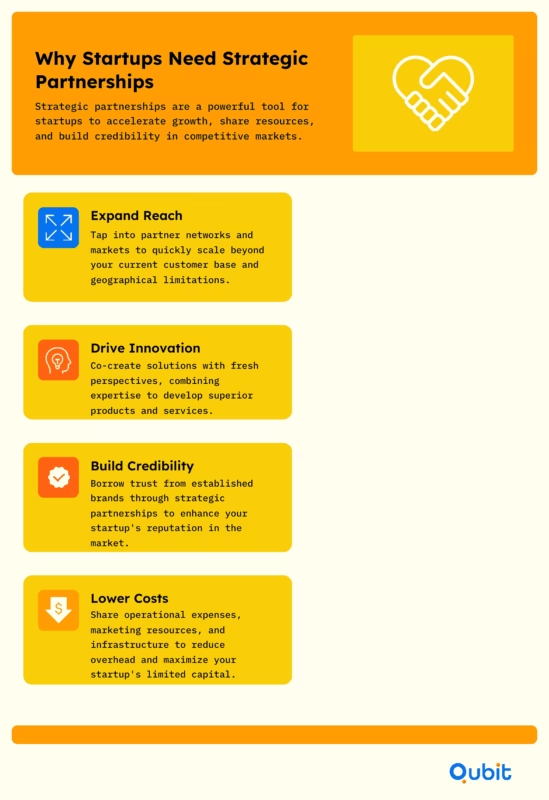Startups with strategic partners have a 30% success rate—triple the baseline. That difference isn’t luck. It’s access, alignment, and shared momentum.
This post focuses on how to use partnerships to unlock capital, attract investors for business growth, and scale faster without going it alone. Whether you're teaming up with brands, platforms, or distribution channels, the right collaboration can bring more than cash—it can shape your trajectory.
We’ll cover the types of partnerships that work, common risks, and how to approach these deals strategically. If you're exploring broader capital strategies, this breakdown of types of startup funding puts partnership-based models in context.
What You Need to Know About Strategic Partnerships and Their Types
Strategic partnerships are a cornerstone of modern business growth, offering diverse models that cater to varying needs. From vendor collaborations to corporate accelerators and investor-led initiatives, these partnerships can significantly reduce operational costs and enhance funding opportunities.
Vendor Collaborations: Streamlining Costs
Vendor collaborations are a practical approach to aligning supply chains and optimizing resource allocation. By fostering productive relationships with vendors, businesses can reduce inefficiencies and lower costs. For example, supply-chain alignment through vendor partnerships has been shown to improve operational outcomes. Vendor Collab illustrates how these collaborations can streamline processes and enhance productivity.
Vertical Integration Partnerships: Enhancing Efficiency
Vertical integration partnerships involve startups collaborating across different positions within the value chain. This model not only streamlines operations but also reduces capital burn rates by 30–40%. By integrating processes across the supply chain, businesses can achieve greater efficiency and minimize redundancies.
Corporate-Led Models: Accelerators and Beyond
Corporate-led partnerships often take the form of accelerators, venture client units, sandbox trials, or hybrid venturing hubs. These initiatives provide startups with access to resources, mentorship, and market opportunities, fostering innovation and growth. For instance, accelerators offer structured programs that help startups refine their business models and scale effectively.
Investor-Oriented Models: Unlocking Funding Potential
Investor-led partnerships, including those involving Forbes 400 family offices, focus on providing financial backing and strategic guidance. These models are particularly beneficial for startups seeking to secure funding while gaining insights from experienced investors.
Strategic partnerships, whether vendor-based, vertically integrated, or investor-oriented, offer tailored solutions to address specific business challenges. Bootstrapping strategies for startups can complement these partnerships by providing self-funding insights that align with external collaborations.
Strategic partnerships are not one-size-fits-all; they are dynamic frameworks that adapt to the needs of businesses, driving growth and innovation across industries.
Why Strategic Partnerships Can Benefit Your Business
Collaborations with the right partners can transform the trajectory of your business. Strategic partnerships offer a unique opportunity to amplify market reach, reduce operational costs, and enhance brand credibility. By combining complementary resources and networks, businesses can unlock innovation and access untapped markets.

Expand Market Reach Through Partner Networks
Partnering with established organizations allows businesses to tap into extended networks and reach new audiences. For instance, joint promotions can significantly boost brand visibility. Integrating Marketing Tips from WordStream highlights how collaborative marketing strategies can expand your reach and strengthen customer engagement.
Drive Innovation with Complementary Resources
Strategic alliances often bring fresh perspectives and innovative ideas to the table. By pooling resources, businesses can create robust pipelines of new offerings that cater to evolving market demands. This approach fosters an entrepreneurial culture, attracting top talent and encouraging creative problem-solving.
Strengthen Brand Credibility
Collaborating with reputable partners enhances your brand’s credibility. Large-scale partnership ecosystems, such as Microsoft's, demonstrate the power of collaboration. With 95% of its revenue generated through partnerships and 7,500 new partners joining monthly, Microsoft exemplifies how strategic alliances can build trust and drive growth.
Lower Operational Costs
Pooling resources with partners can reduce expenses across various operational areas. Shared infrastructure, joint marketing campaigns, and co-developed products minimize costs while maximizing efficiency. This financial advantage is particularly appealing for businesses aiming to optimize their budgets without compromising quality.
Strategic partnerships are more than just collaborations—they’re catalysts for growth. By discovering new markets, fostering innovation, and building credibility, businesses can position themselves for long-term success.
Your Guide to Executing Successful Strategic Partnerships
Step 1: Reduce Market Uncertainty in Your Partnership
Strategic partnerships reduce exposure to market shocks and regulatory changes. By pooling resources and building in flexibility, partners can respond faster to new conditions. These alliances also provide access to capital buffers—from credit lines to microloans for startups—that help maintain momentum during volatility.
Step 2: How AI Is Changing Partnership Dynamics
AI is influencing everything from partner selection to performance tracking. Around 30% of partnership decisions now rely on AI-driven analysis, helping teams predict outcomes, streamline negotiations, and measure success. Companies like OpenAI are already integrating AI into decision workflows to increase speed and accuracy.
Step 3: Find New Opportunities for Value Creation
Effective partnerships go beyond shared marketing. They uncover innovation bricks—pieces of tech, process, or talent—that create long-term value. These can open new channels for investors for business expansion or bring new products to market faster.
Step 4: Build Stronger Engagement with Your Partners
Trust builds better outcomes. Engagement happens through joint planning, co-marketing, and shared wins. Networking programs and incubators help strengthen these ties, especially in early-stage collaborations.
Step 5: Set Up Governance and Legal Structures That Work
Governance defines how decisions get made. Use simple but agile frameworks: outline roles, create fallback scenarios, and clarify IP ownership. Legal structure should support the long-term plan—not just today’s goals. Tools like a business plan template can help document expectations early.
Step 6: Learn from Accelerator and Ecosystem Success Stories
Programs like MassChallenge-Inspiralia, Toyota Startup Accelerator, and Target Accelerator have shown how structured partnerships lead to real funding outcomes. These ecosystems pair startups with the right partners, exposure, and capital. Behind many successful startup collaborations is a support layer that builds momentum early.
Step 7: Actionable Recommendations for Better Partnerships
- Map out shared goals and define how success is measured.
- Use AI to identify blind spots and validate assumptions.
- Look beyond equity—revenue-based financing explained adds flexibility alongside partnerships.
- Prepare your governance documents with future funding rounds in mind.
If you're ready to connect with the right partners, we at Qubit Capital can facilitate introductions through our Investor Outreach service. Let's elevate your funding journey together.
Avoid Common Pitfalls in Strategic Partnerships
Strategic partnerships can unlock significant growth opportunities, but they often come with challenges that require careful planning. Missteps such as resource overcommitment, unpaid trials, and legal vulnerabilities can derail even the most promising collaborations.
1. Define Clear Objectives
Ambiguity in goals often leads to misaligned expectations between partners. Before entering a partnership, establish measurable objectives that outline mutual benefits and responsibilities. This ensures both parties remain focused on shared outcomes rather than conflicting priorities.
2. Avoid Resource Overcommitment
Excessive allocation of time, money, or effort can strain your business operations. Structured budgets and resource allocation plans are essential to prevent partnerships from draining your company’s funding or workforce. For example, the trend of "Overcommitting Resources" highlights how unchecked enthusiasm can impede growth.
3. Assess the Risks of Unpaid Trials
Engaging in unpaid pilot programs may seem like a low-risk way to test partnerships, but they can undermine cash flow and devalue your offerings. Hidden costs, such as time spent on unpaid engagements, often outweigh the perceived benefits. Address these risks upfront by setting clear terms for pilot programs.
4. Prioritize Legal Safeguards
Insufficient legal protections can expose your business to unnecessary risks. Robust contracts that outline terms, responsibilities, and exit strategies are critical for mitigating legal hazards. Without these safeguards, partnerships can complicate future acquisitions or limit growth potential.
5. Evaluate Partner Synergy
Failure to evaluate partner synergy can derail company growth. Identifying "Red Flags" early—such as misaligned values or conflicting business models—can save your company from costly mistakes.
Strategic partnerships thrive when built on transparency, structured planning, and mutual accountability. By addressing these common pitfalls, businesses can foster collaborations that drive sustainable success.
Many founders combine strategic relationships with creative financial tools. The range of alternative funding for startups expands what's possible when building around shared goals.
Conclusion
Strategic partnerships thrive when built on shared objectives and clear frameworks. By aligning partnership goals with funding aspirations, businesses can ensure that collaborations drive mutual success. Structured communication, well-defined roles, and actionable strategies are essential for maintaining focus and achieving measurable outcomes.
If you're looking to secure the right investors, we at Qubit Capital can support you through our Fundraising Assistance service. Connect with us today to boost your funding prospects.
Key Takeaways
- Strategic partnerships significantly boost a startup’s funding prospects and market credibility.
- Different models—from vendor collaborations to corporate accelerators—offer unique advantages.
- Benefits include market expansion, innovative pipelines, and enhanced investor confidence.
- Common pitfalls such as over commitment and ineffective legal structures must be managed proactively.
- Actionable strategies, including AI integration and agile governance, are critical for long-term success.
Frequently asked Questions
How to get partnerships for startups?
Start by leveraging your network, attending relevant industry events, and exploring accelerator or incubator programs that foster partnership opportunities.


 Back
Back



